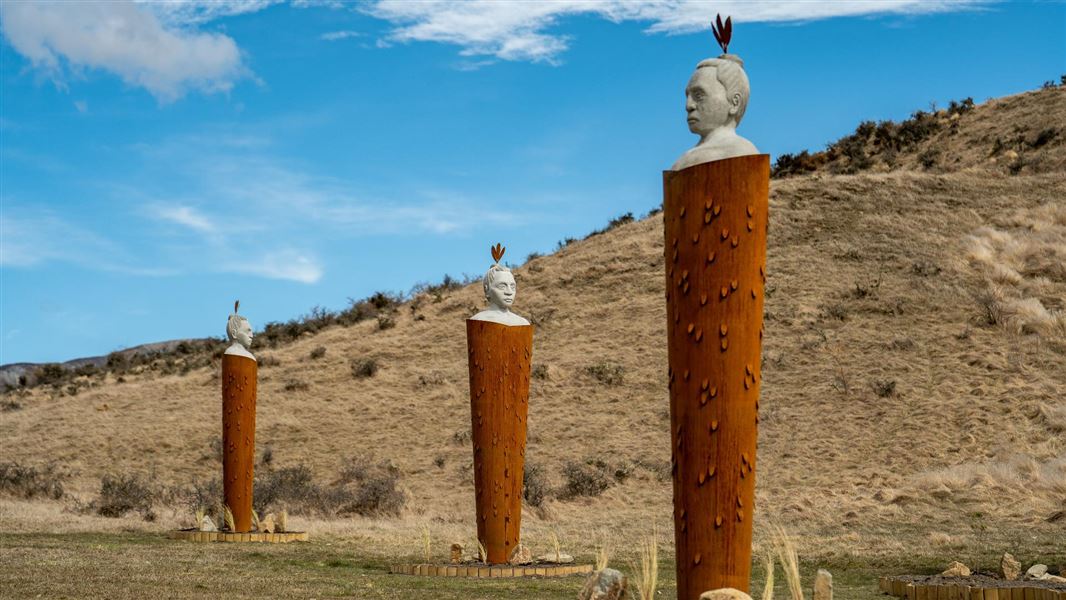Archived content: This media release was accurate on the date of publication.
Date: 20 September 2022
The pou whenua were installed as part of a significant upgrade to protect the cultural values of Kura Tawhiti and celebrate this important site, in collaboration between Ngāi Tūāhuriri whānui and the Department of Conservation/Te Papa Atawhai (DOC).
Seven information panels have been installed with narratives covering Ngāi Tūāhuriri/Ngāi Tahu history. Ngāi Tūāhuriri is the hapū which descends from the ancestor Tūāhuriri and holds rangatiratanga over Kura Tawhiti.
Ngāi Tūāhuriri spokesperson Joseph Hullen says the three pou whenua represent the rangatiratanga of the hapū and the tōpuni status of the whenua.
“This is an opportunity for place-based storytelling, for us to tell our stories, our way, for all visitors to enjoy. The pou whenua depicting our tīpuna give Ngāi Tūāhuriri a visual presence on the landscape, so manuhiri (visitors) may learn our stories and the history of Kura Tawhiti.”
Kura Tawhiti is one of 14 tōpuni sites across Te Waipounamu, which are areas legally recognised as culturally significant to Ngāi Tahu.
The new pou whenua, designs for the shelter, and information panels at Kura Tawhiti were created by master carvers Fayne Robinson (Ngāi Tahu) and Riki Manuel (Ngāti Porou). The stories shared on the information panels are from Ngāi Tahu tīpuna who were alive in the late 1800’s. Their stories were recorded in Ngāi Tahu manuscripts and by early European historians.
DOC Eastern South Island Operations Director Jo Macpherson says the upgrades will help visitors to understand and respect the cultural significance and heritage values of the area. They will also protect the fragile ecosystem.
“The Department of Conservation is focused on working with mana whenua to appropriately acknowledge and celebrate the cultural significance and stories of the places under our care. It’s incredibly rewarding to see the results of working with Ngāi Tūāhuriri whānui to restore their values into this site.
“What a gift for visitors to this special place who now get to connect with the cultural, spiritual and historical significance of Kura Tawhiti, which will enrich their experience at the site.”
This is a hugely popular site and deeply special to so many of us, says Jo Macpherson.
“More than 100,000 visitors a year stop to take in the stunning limestone rock formations – a number that’s expected to increase.”
“The ecology of the site is fragile and can be damaged by large numbers of people walking through it. The new track and native plantings will help to guide visitors through the site and protect the unique landscape.”
As well as the pou whenua and the new information panels, other upgrades include the construction of a new loop track, native plantings, and new shelters and picnic tables.
Ngai Tūāhuriri are actively involved in key decisions about the management of Kura Tawhiti.
Background
Kura Tawhiti means “the treasure from a distant land”. Kura Tawhiti was claimed by the Ngāi Tūāhuriri ancestor Tūrākautahi and Tane Tiki, sons of celebrated chief Tūāhuriri. The nearby mountains were famed for kākāpō, and they wanted their soft skins and glowing green feathers for clothing to be worn their daughters.
The three pou whenua represent ancestors with a connection to Kura Tawhiti:
- Tawhitinui: a passenger on the Ārai Te Uru waka which left from Itaitewhenua, a place said to be beyond Hawaiki. As the Ārai Te Uru travelled down the coast from Kaikōura to Moeraki many of the passengers slipped overboard and swam ashore, among them Tawhitinui, Waimakariri and Tawera. Tawhitinui became Kura Tawhiti while Waimakariri changed into a river, and Tawera became Mount Torlesse.
- Tūrākautahi and Tāne Tiki: Tūrākautahi and Tāne Tiki were sons of Tūāhuriri.
They each claimed mountain peaks along the Torlesse Range, saying:
- “Ko Kuratawhiti, te maunga, ko au te takata.” - Kuratawhiti is the mountain, and I am the man – Tūrākautahi.
- “Mōku tēnā maunga, kia maro ai a Hinemihi rāua ko Hutika i te maro-kākāpō” - Whata-a-rama is mine, to clothe my daughters Hine-mihi and Hutika in kilts made from kākāpō – Tane Tiki.
Pou whenua are placed prominently as a strong symbol of cultural and historic significance, contributing to the cultural heritage of Aotearoa New Zealand in a specific location.
Tōpuni publicly recognise Ngāi Tahu mana and rangatiratanga over culturally significant sites on public conservation land and ensures Ngāi Tahu values are recognised, acknowledged and provided for at these sites. There are 14 tōpuni across Te Waipounamu/the South Island.
Contact
For media enquiries contact:
Email: media@doc.govt.nz
